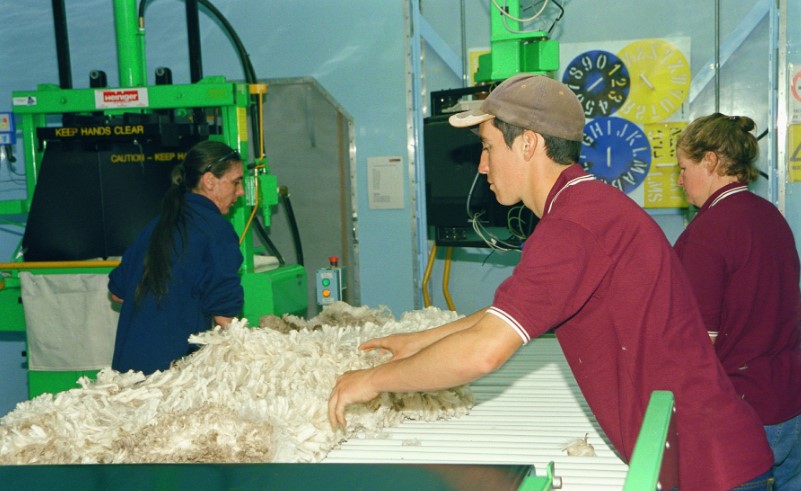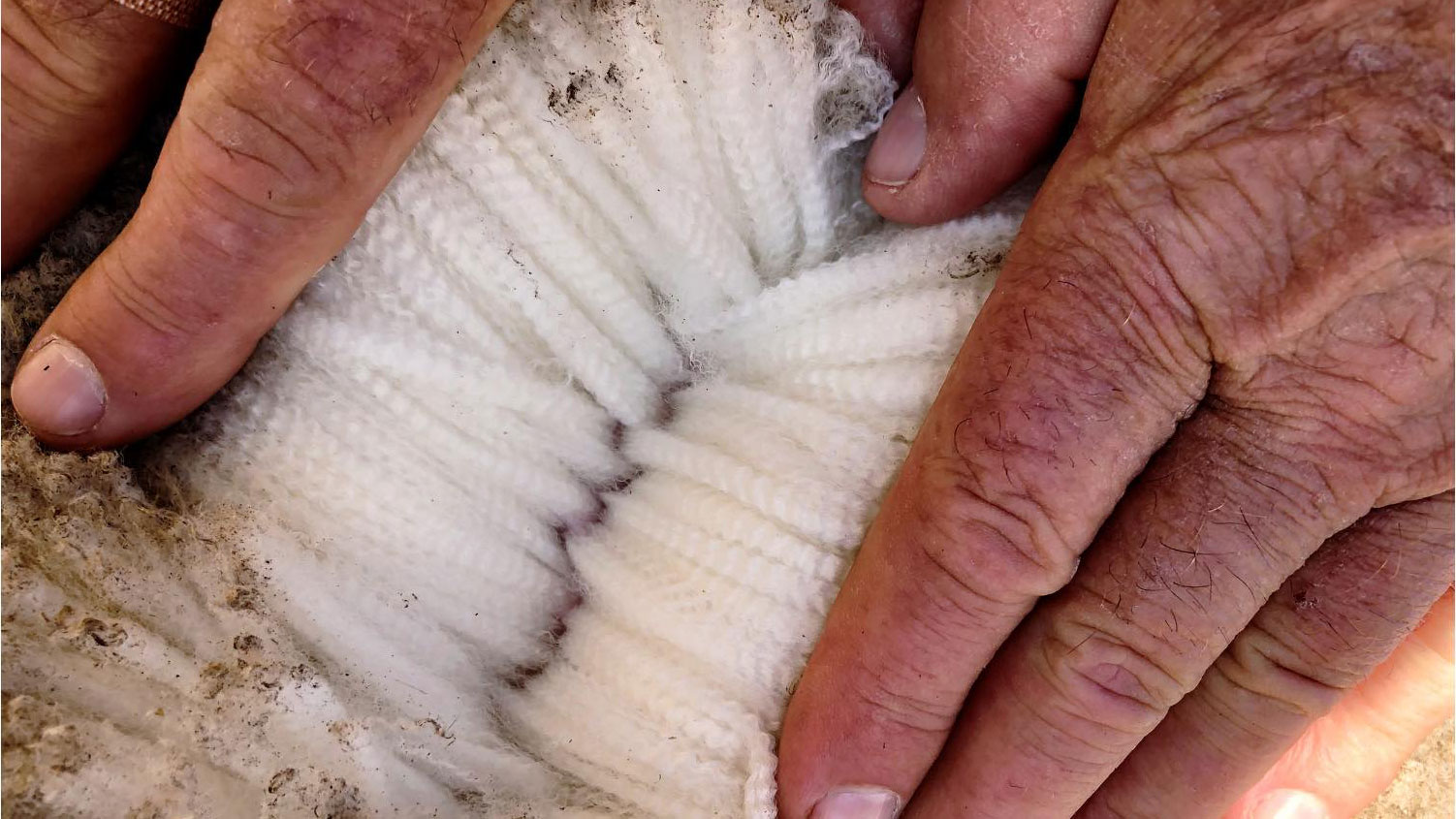Chapter 2.2 Use a customer focus to produce, harvest and prepare wool for sale
Chapter 2.2 Use a customer focus to produce, harvest and prepare wool for sale
Background information
The Australian Wool Exchange (AWEX) Code of Practice: For the Preparation of Australian Wool Clips - The Wool Classer describes the recommended practices and standards. The code aims to:
- Prepare uniform, consistent, reliable, predictable, low risk lines of wool suitable for the diverse needs of wool processing to maximise competition from buyers for the wool.
- Present a product free of contamination that is correctly documented, described and packaged.
Clips prepared to the Code of Practice will meet the needs of wool processors and attract the maximum competition at auction to maximise your return.
Australian wool is renowned worldwide for its whiteness and cleanliness, and consequently commands premiums compared to wool from other countries.
Contamination of the Australian Merino wool clip has mostly been associated with dark fibres originating from urine stain and isolated pigmentation found in the fleece. In recent years the introduction of exotic sheep breeds has brought a new and increasing source of dark and medullated fibre contamination. This contamination costs about $100 million each year to remove or correct by picking out from fabric after weaving.
At a glance
- Understand the benefits of developing relationships that underpin the annual production, harvesting and preparation of wool.
- Use the AWEX Code of Practice for Wool Classers to manage and supervise shearing, preparation and classing activities.
- Discuss your shearing plans with your broker and secure their shearing stationery.
- Consider producing for the growing market for credentialled wool.
Cost of production
Cost of production (COP) is a key factor affecting the profitability of wool producing businesses. COP, measured in dollars per kilogram of clean wool, is an indication of the outlay needed to produce each kilogram of wool (see tool 1.8 in MMFS Module 1 Plan for Success). Calculating the cost of production is an important step in assessing and improving the performance of a wool-growing enterprise. COP is most useful when calculated over multiple years to track trends and influences over time and reduce the impact of seasonal variation.
The key benefits of knowing your COP are to:
- Provide a benchmark to measure the performance of your wool enterprise year on year.
- Enable a comparison of the efficiency of your enterprise annually with other woolgrowers.
- Identify any opportunities for improvement and where your enterprise is performing well.
- Help set a target sale price which will achieve a satisfactory profit margin and help determine the right time and price to market your wool.
Managing shearing
Shearing management and wool harvesting practices can have a big influence on quality of wool sold. Tool 2.4 contains basic guidelines to assist with planning for shearing, wool preparation and classing.
Dark and medullated fibre contamination

AWI-funded research by CSIRO developed the dark and medullated fibre (DMF) test for use on wool core-samples routinely used for yield and micron testing by the Australian Wool Testing Authority (AWTA). For around $40 (plus GST), the voluntary DMF test:
- Enables Australia’s white-wool producers to promote their wool as such to buyers.
- Provides buyers and processors with a reliable and quantified measure of the level of dark and/or medullated fibre risk in sale lots.
The Dark and Medullated Fibre Risk (DMFR) Scheme is a declaration that rates clips for contamination risk and advises purchasers of Australian wool of the likely level of contamination of white wool from traditional natural pigmentation or stains and new sources such as exotic breeds.
The DMFR declaration requires Australian woolgrowers to formally identify the following information on their wool classer’s specification or associated declaration form:
- If their stock have been in contact with exotic sheep breeds
- If crutched
- If crutched within 3 months of shearing
- Age (important if this is the sheep’s first shearing and also as they age)
- Sex
- Wool description.
Tool 2.3 describes how this information contributes to the ratings. Though lots of classer’s specification forms include a section for this information, it is strongly recommended you complete the National Wool Declaration (NWD) to accompany all sale lots to give buyers the full range of information.
Woolgrowers can nominate all, some, or certain lines in their wool clip for inclusion in the voluntary declaration scheme. However, you must sign the statutory declaration form to make this valid in the catalogue.
Credentialled wool
Market research indicates there is growing demand for credentialled wool – whether this is animal welfare- or environment-related, or a combination of both. Typically, credentialled wool products are those made from fibre grown in an environmentally sustainable manner (see chapter 5.3 in MMFS Module 5 Protect Your Farm’s Natural Assets) and that recognise animal welfare (see chapter 11.5 in MMFS Module 11 Healthy and Contented Sheep), human rights and social justice standards.
The demand for information about environmental and ethical sustainability in food and fibre products has accelerated significantly since the pandemic as consumers now see their purchase decisions as an agent for change. This ‘eco-awakening’ has important implications for wool and how it is positioned as a natural, renewable and environmentally friendly fibre choice. Having the evidence to back up any claims is paramount.
Australian wool is well positioned to meet this growing market demand with its ‘natural’ credentials – it is a natural, renewable, biodegradable protein, produced in extensive grassland ecosystems. However, assurance of these credentials at finished product stage requires proof of compliance to certain standards through the supply chain.
The industry is working to enable all stages of the wool supply chain to:
- achieve sustainability goals and help our industry deliver positive outcomes for people, planet and prosperity.
- dress the world in the most sustainable, circular fibre of the past, present and future.
- support Australian woolgrowers profitably produce the world’s most sustainable fibre, optimal for circular, traceable products.
- position Australian woolgrowers as proactive, socially responsible and forward-looking stewards of the environment, building natural capital on their farms.
There are many different QA schemes and declarations with different priorities and requiring different forms evidence of on-farm practices which allow them to accredit the wool in their scheme as having been produced in a certain way. A lot of growers already meet the requirements of many of the schemes, so the best option is to discuss with your broker which schemes your wool may be eligible for, how much they cost to participate in and the likely increase in competition or price received for your wool as a result of participating in the scheme to make an informed decision for your business.
It is recommended that, regardless of which QA scheme you do or do not participate in, you complete a National Wool Declaration (NWD) for all sale lots. The NWD delivers transparency in the supply chain and market analysis has show declared wool sells for a higher price than wool that is not declared.
Best practice chemical use
It is of paramount importance that label directions are followed for all chemicals used on-farm to achieve the most cost-effective control and reduced likelihood of developing chemical resistance issues, and adhere to safe levels set for environmental protection, sheep and human safety and quality of final product (both wool and meat).
To achieve the correct application of chemicals, woolgrowers should read product labels closely (and the material safety data sheet, if necessary) and take care with the preparation and dispensing of the product.
Equipment must be suitable and set up correctly. Ensure correct calibration of the delivery tools and apply the product to well-prepared and contained sheep. Operators must take time and care with every sheep.
To ensure the safety of the operator:
- Follow the safety direction on the label.
- Store chemicals correctly and securely.
- Wear protective gear.
- Carefully pour and mix chemicals.
- Have water, soap and towel ready to wash splashes off.
- Have clean-up equipment ready for spills.
- Wash hands before eating, drinking or smoking.
- Wash and store equipment straight after use.
- Change your clothes when you have finished chemical work.
SIGNPOSTS
WATCH & LISTEN
Discover the amazing journey of wool from the farm through the global supply chain to create innovative wool fabrics and garments. Wool is processed by two methods, worsted processing and woollen processing. Wool fabrics create luxurious, technical and eco-friendly products.
A demonstration of what is required from a wool handler in a shearing shed, handling and working the belly wool, removing the crutch, picking up & throwing the fleece.
Shows the reasons we separate wool types (e.g., fleece, crutch, belly, shanks, etc.) into different lines and how it suits different processing routes.
READ
Undertaking a broad review of the global market for wool and competitor fibres, AWI is able to provide wool production forecasting, retail and trade market reports, consumer insights and trend monitoring, along with fibre market research.
Quarterly magazine for AWI shareholders and industry stakeholders to keep up to date on the latest R&D and extension outcomes, marketing campaigns and developments for the wool industry.
An Australian industry document (administered by AWEX) that describes the recommended practices and standards to which wool should be prepared.
Market commentary from Macdonald & Co Woolbrokers.
As well as offering a range of daily and weekly market summaries detailing the current market movements, AWEX Market information provides real-time data during Australian wool auctions.
The latest on the Australian wool market direct from the Elders wool team.
Stay up to date with what’s happening in the wool market from the team at Nutrien.
What did the wool market do this week? Hear from AWN.
Jemalong Wool market insights.
Weekly market report from Moses and Son.
Every week, Quality Wool brings you a summary of the week in wool.
Weekly report and information pages from Schute Bell Badgery Lumby.
Program to protect the reputation of Australia's premium Merino white wool by managing the risk of dark and/or medullated fibre contamination.
USE
Search for registered parasite treatment products for flies, lice, worms and ticks in sheep, cattle and goats.
The NWD is used to declare animal welfare practices and Dark and Medullated Fibre Risk (DMFR) to wool exporters, processors and retailers. It is the trusted declaration method for Australia and once completed, the information is converted by the wool selling agent for inclusion in sale catalogues and test certificates.
Can be used by wool classers and growers to manage the wool clip from in-shed to the end of the wool pipeline, AWEX WoolClip is the fast, free, fully mobile way to specify, complete the NWD and follow the BaleTrail.
Templates for use in the shed, including The pre-shearing check list, Classer speci and AWEX Bale description charts.
An industry owned and led initiative, the Hub is an opportunity for the Australian wool industry to get ahead of the curve when it comes to Australian wool's Emergency Animal Disease response plan as well as end-to-end commercial traceability from farm to first stage processor. For Woolgrowers, it provides ease of access to all their clip test information.
ATTEND
A treasure trove of free, interactive resources and coursework for wool industry participants of all ages and backgrounds. Sign up for a free account and avail yourself of the information across the supply chain and see more of what is important to Australia’s wool customers and consumers.
Contact your wool broker to organise a trip to the wool auctions. The auctions provide a valuable tool in providing production comparison to your wool clip. On the wool show floor, look at your own wool samples and take the time to view and compare other wools grown from your region and to a similar spec as yours. During the auction, take note of prices received by other growers. The wool sales also provide opportunities to interact with many of the exporters, giving a global perspective on pricing, preparation and future demand issues.






